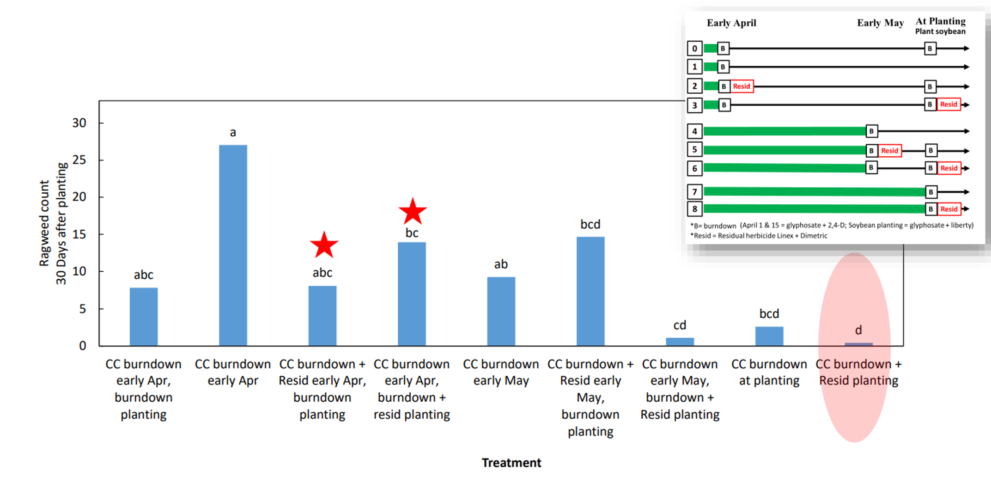Common ragweed (Ambrosia artemisiifolia L.) is very widespread in the soybean plantations of Québec and Ontario. As a result, it can reduce yields by up to 50%! So, today we explain how to manage its occurrence in your fields!
The propagation of common ragweed can be attributed to various factors, such as its ability to produce large numbers of seeds (between 100 and 6000 seeds per plant) and its adaptability to different soil types and environmental conditions.
Indeed, it is found in a variety of locations: wastelands, roadsides, and cultivated fields. It thrives near grain and row crops such as corn and soy.
Herbicide resistance of common ragweed
Common ragweed is difficult to eliminate because of its resistance to certain herbicide groups. In 2021, MAPAQ’s Laboratoire d’expertise et de diagnostic en phytoprotection (LEDP)[1] observed that a common ragweed population in Mirabel, Québec was resistant to group 2 and group 14. It was the very first population found to be resistant to group 14 in Canada!
Maryland study
On the Lower Eastern Shore of Maryland, common ragweed has become resistant to multiple herbicide groups. Indeed, Glyphosate (group 9), Firstrate (group 2) and Reflex (group 14) are no longer effective in controlling the spread of ragweed on farms.
Area farmers are having to turn to a more costly and limited selection of herbicides. Which is why Sarah Hirsh at University of Maryland is researching more effective solutions.
The first part of the study focuses on early-season management, as this is when 95% of the ragweed emerges. The research compares the two options available to area farmers: cover crops, and herbicide application before and after planting.
Hirsh notes that the majority of Maryland farms plant wheat cover crops for weed control. Over three seasons, her research evaluated the effect of different cover crop burndown dates on common ragweed populations.
Cover crop management to control common ragweed
Between 2019 and 2020, Hirsh analyzed three wheat cover crop burndown dates on three farms. The 2021 trial evaluated only two burndown scenarios but also the differences between the use and nonuse of cover crops on common ragweed.
Over the course of the study, Sarah Hirsh observed that farmers use glyphosate and 2,4 D in the pre-planting burndown. During planting, they use Glyphosate plus and Glufosinate instead. For the residual applications, they use Linuron plus and Metribuzine (Lorox + Sencor).

Source : Sarah Hirsh, University of Maryland
The above graph represents the common ragweed populations by cover crop burndown date between 2019 and 2020. It also illustrates the average ragweed populations 30 days after planting during these same years.
The inset at the top right of the graph summarizes the herbicide application dates. The green line shows the wheat’s active growth periods. The tiny white squares with the letter P represent a pre-planting herbicide application. And the red square with the term Resid marks the application of a residual herbicide. All the treatments are listed along the horizontal axis of the graph.
In conclusion, cover crops work best, especially if the soybean crop is planted at the same time as the cover crop burndown. Cover crops have a significant impact on the development of ragweed. The longer the cover crops are allowed to grow, the more biomass they produce, and the lower the weed emergence.
That’s not all. A residual herbicide application during planting also reduces ragweed development. On the other hand, herbicide application after planting shows no advantage.
For more information, contact your Prograin representative!
Sources :
AGRIRÉSEAU. (2021, 8 septembre) Malherbologie, Avertissement No 11. Réseau d’avertissements phytosanitaires (RAP). https://www.agrireseau.net/rap/documents/108117/malherbologie-avertissement-no-11-8-septembre-2021
CÉROM. (2023). Fiche Technique : La petite herbe à poux (Ambrosia artemisiifolia L.) résistante aux herbicides. https://www.agrireseau.net/documents/Document_97475.pdf
CRAAQ. (2023). Fiche technique, Petite herbe à poux. IRISS phytoprotection. IRIIS phytoprotection – Fiche technique, Petite herbe à poux (syn. Herbe à poux) – Common ragweed
Temple, L. (2022, September 6). Herbicide Resistant Common Ragweed Control Limiting Emergence. Soybean Research and Information Network. https://soybeanresearchinfo.com/research-highlight/herbicide-resistant-common-ragweed-control-limiting-emergence-part-1-of-2/
[1] The plant protection expertise and diagnostics laboratory at Québec’s Department of Agriculture, Fisheries and Food.
